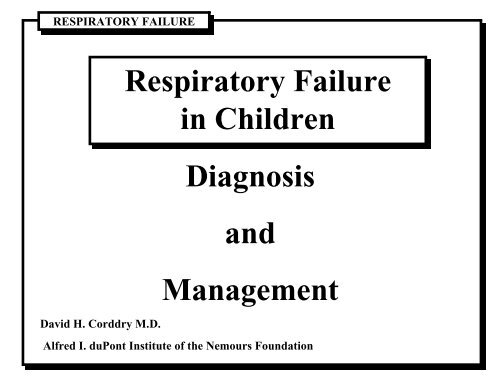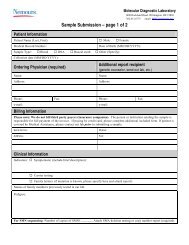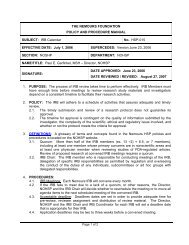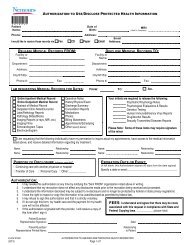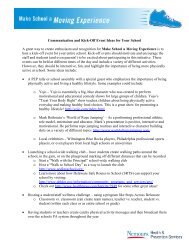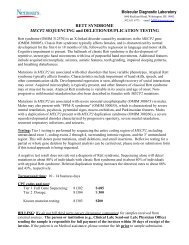Respiratory Failure in Children - Nemours
Respiratory Failure in Children - Nemours
Respiratory Failure in Children - Nemours
You also want an ePaper? Increase the reach of your titles
YUMPU automatically turns print PDFs into web optimized ePapers that Google loves.
RESPIRATORY FAILURE<strong>Respiratory</strong> <strong>Failure</strong><strong>in</strong> <strong>Children</strong>DiagnosisandDavid H. Corddry M.D.ManagementAlfred I. duPont Institute of the <strong>Nemours</strong> Foundation
RESPIRATORY FAILUREObjectivesDef<strong>in</strong>e <strong>Respiratory</strong> <strong>Failure</strong>.Review Physiology of Respiration.Catagorize <strong>Respiratory</strong> <strong>Failure</strong> by PhysiologicMechanisms.Develop an approach to Etiologic Diagnosis.Outl<strong>in</strong>e Treatment Modalities based on Physiology andEtiology.Discuss Exemples - i.e. Acute Upper AirwayObstruction.
RESPIRATORY FAILUREDef<strong>in</strong>itionInability to meet one's need for tissue oxygenation andelim<strong>in</strong>ation of CO2, often but not always associated withdistress.Will focus on Pulmonary aspects of this process.50% of pediatric ICU admissions.Produced by a wide variety of diseases.
RESPIRATORY FAILUREOrientationOxygenation and Ventilation are Essential toLiv<strong>in</strong>g.# Two simultaneous goals <strong>in</strong> management.Diagnosis and treatment of underly<strong>in</strong>g disease.# Amelioration of pathophysiology produc<strong>in</strong>g ARF,<strong>in</strong>dependent of diagnosis.Relative importance depends on degree of failureand rate of change.# Focus on Physiologic Approach
RESPIRATORY FAILURE<strong>Respiratory</strong> Physiology# Developmental aspects# Ventilation: Dead Space, Distribution, LungVolumes, FRC, Clos<strong>in</strong>g Capacity# Mechanics: Work, Compliance, Resistance, TimeConstants, Visco-Elastic Properties, Surfactant# Perfusion: Lung Zones, HPV,# V/Q match<strong>in</strong>g: Shunt, Venous Admixture, VirtualShunt, Alveolar gas equation, A-a gradient.
RESPIRATORY FAILUREDevelopmental Physiology# Conduct<strong>in</strong>g Airways relatively smaller 1st 5 years.# Cartilage spread to segmental bronchus, 12 w gest.# Alveoli: fewer, smaller, less surface area /BSA# Neonates, Premies: Pause, Apnea, Flat CO2 response,Decrease V to hypoxia# Chest wall compliant: deforms, wastes effort.
RESPIRATORY FAILUREDead Space# A. Anatomic = Conduct<strong>in</strong>g Airways, 2ml/kg# B. Alveolar = non perfused alveoli (PE, hypo tension,excess PEEP, CC > FRC)# Physiologic = A + B# VD = (PaCO2 - PECO2) VE / PaCO2# Normally VD /Vtidal = 0.3# This <strong>in</strong>creases <strong>in</strong> most disease states.# More on this under V /Q match<strong>in</strong>g.
RESPIRATORY FAILUREDistribution of Ventilation# More ventilation to bases <strong>in</strong>healthy lungs due to less P-transpulm. at endexpiration.# Shift <strong>in</strong> pressure -volumerelationship can change thisdramatically.VbaseapexP transpulmonary
RESPIRATORY FAILURELung VolumesTidalVolumeVitalCapacityTotalLungCapacityClos<strong>in</strong>gCapacityFuncionalResidualCapacityResidualVolume
RESPIRATORY FAILUREFRC# Volume <strong>in</strong> Lung at end expiration. Balance betweenfactors favor<strong>in</strong>g collapse, and those favor<strong>in</strong>g expansion.# Represents gas volume available for exchange.# Faster desaturation at lower FRC.# Lower FRC favors atalectasis.
RESPIRATORY FAILUREConvergence of FRC and CCElevation of CCInfancyBronchiolitisAsthmaBPDSmoke InhalationCystic FibrosisReduction of FRCSup<strong>in</strong>e PositionAbdom<strong>in</strong>al DistensionSurgery, AtalectasisPulmonary edemaNear Drown<strong>in</strong>gARDS, Pneumonitis
RESPIRATORY FAILUREWork of Breath<strong>in</strong>g# Done dur<strong>in</strong>g <strong>in</strong>spiration.# Overcome tissue viscoelasticresistance of lungand chest wall.# Move air <strong>in</strong>to lungs ag<strong>in</strong>stresistance to flow.#Tissue returns work tomove air out.T Vi od la ul meFRCexpiration<strong>in</strong>spirationDistend<strong>in</strong>g Pressure
RESPIRATORY FAILURECompliance# Lung compliance# Chest Wall compliance# Total compliance# Specific compliance is<strong>in</strong>dexed to FRC.VFRCPressure
RESPIRATORY FAILUREDecreased Total ComplianceDecreased CLIncreased RecoilARDS, pneumonitisedema, neart drown<strong>in</strong>gOverexpansionAsthma, BronchiolitisToxic or Thermal InhalationExcess PEEP or CPAPVolume lossDecreased CWThoracic Trauma or SurgeryAbdom<strong>in</strong>al SurgeryDiaphragmatic Load<strong>in</strong>gAbdom<strong>in</strong>al DistensionPD, MASTPneumothoraxPleural EffusionThoracic Bony deformitiesAtalectasis Sup<strong>in</strong>e position
RESPIRATORY FAILUREResistance# Pressure change needed to produce Flow.# Lam<strong>in</strong>ar flow def<strong>in</strong>ed by Hagen-Poiseuille.equation:Resistance = P / V = 8 h l / r4# Turbulent flow <strong>in</strong>creases resisitance, and makesresistance flow dependent..such that P is2proportional to V and density.# 1 / Resisitance = Conductance.# Specific Conductance = Conductance / LungVolume. SImilar <strong>in</strong> <strong>in</strong>fants and adults.
RESPIRATORY FAILURESites of Increased AirwayResistance# In Adults -- Upper Airway, Nose.# In <strong>Children</strong> -- Peripheral Airways.# Dynamic Airway Compression: Increased Intrapleuralpressure dur<strong>in</strong>g forced exhalation augments collapse of<strong>in</strong>trathoracic airways.# Worse with BPD, alpha-1-antitryps<strong>in</strong> deficiency due topoor cartilege.# Extrathoracic airway effected on <strong>in</strong>halation.
RESPIRATORY FAILURETime Constants# Time required for lung unit to fill to 63% of f<strong>in</strong>al volume.# Time constant = Resistance x Compliance# Those alveoli with shorter time constants fill faster.# Local variation <strong>in</strong> resistance and compliance effect gasdistribution.# e.g. overall TC is <strong>in</strong>creased <strong>in</strong> Asthma
RESPIRATORY FAILURESurfactant# LaPlace's Law P = 2 T / r# This would predict that small alveoli would empty <strong>in</strong>tolarge ones.# However Surfactant allows a decrease <strong>in</strong> surface tensionas the radius decreases.# Therefore Pressure stays the same.# Made by type II pneumocytes.# Surfactant deficiency occurs <strong>in</strong> many disease states.
RESPIRATORY FAILUREPulmonary Circulation# Development closely follows airway / alveolardevelopment.# Limited <strong>in</strong> pulmonary hypoplasia (eg CDH)# Muscular wall actively remodels dur<strong>in</strong>g development.# Smooth muscle gradually extends more distally, but mayextend faster with ensu<strong>in</strong>g Pulm. Ht'n.# Pulm circulation recieves the entire C.O.
RESPIRATORY FAILUREWest Zones II1PAPA>PPA>PPV2PPAPAPPVPPA>PA>PPV3PAPPA>PPV>PA
RESPIRATORY FAILUREHPV# Alveolar Hypoxia leads to local pulmonaryvasoconsstriction.# Usually useful to match perfusion to ventilation.# With whole lung hypoxemia it produces pulmonaryhypertension, and possible R to L shunt via PFO.# Chronically leads to <strong>in</strong>creased muscularity and chronicpulmonary hypertension
RESPIRATORY FAILURE. .V / Q Match<strong>in</strong>g# V / Q = 0.6 at bases; = 3 at apices# True shunt is blood with no contact with aerated alveoli.(eg cardiac, atalectasis)# Venous admixture (virtual shunt) amount of mixedvenous blood to add to pulmonary end capillary blood toproduce observed arterial O2 content.# PAO2 = ( FiO2 ( PB - 47 ) ) - ( PaCO2 / R )# Normally A-a DO2 is small due to obligate shunt.
RESPIRATORY FAILUREIdealized alveoliLung UnitsShuntMatched V / QDeadSpace
RESPIRATORY FAILUREVirtual Shunt L<strong>in</strong>esHb10-14 g/dlPaCO225-40 mmHga-v O2 difference5ml/100mlArterialPaO24003002001000 5% 10%15%20%25%30%50%0Inspired O2 concentration (%)20 30 40 50 60 70 80 90 100
RESPIRATORY FAILUREAlveolar-Capillary Membrane# May contribute to "diffussion" block of O2 movement. Butthis mechanism is rarely the sole cause of signifiganthypoxemia.# However, transudation of fluid across the membrane is amajor cause of respiratory failure.# Function of 1. Pressure gradient. 2. Oncotic forces. 3.Filtration Coefficient.# Leads to 1. Decreased Compliance 2. Alveolar collapse ->Shunt -> Increased Aa O2 gradient.
RESPIRATORY FAILUREExclusions# Physiology review has focused on lung physiology.# Also important, but not <strong>in</strong>cluded <strong>in</strong> this review are:1. CNS control of breath<strong>in</strong>g.2. Neuromuscular transmission.3. Muscular function.4. Toxicology5. Cardiac Function and O2 delivery.
RESPIRATORY FAILURESort<strong>in</strong>g it Out 1Won't Breath(lack of Drive)Can't Breath(strength <strong>in</strong>adequatefor work required)CNSToxicAirwaysLungs<strong>Respiratory</strong> Pump# Remember, a child with chronic respiratory disease canpresent <strong>in</strong> acute failure due to an exacerbat<strong>in</strong>g process.
RESPIRATORY FAILURESort<strong>in</strong>g it Out 2AirwayLungPumpExtrathoracic large airwayIntrathoracic large airwaysmall airwaysIncreased clos<strong>in</strong>g capacityDecreased FRCDead SpaceShuntIntrapleuralChest wallNeuromuscular
RESPIRATORY FAILURESort<strong>in</strong>g it it Out 3Stridor Wheeze Rales BS Retract IncCO2 DecO2 CXRX A/W ObsI A/W ObsSmall A/WI > EE > I--+++++---==++++++++++++++++++++-traptrapInc CCDec FRCDead SpShunt----++++++--++-++=-++++++++++++++++++++++++++traplow vol<strong>in</strong>c vollow volI PleuralChest WNeuroM---------=+++++-++++++++++++++shift+ / -bellCNSToxic------==--++++++++++--
RESPIRATORY FAILUREHypoxia# The four basic mechanisms which can produce hypoxia.1. Inadequate FiO2.2. Decreased Ventilation.3. Shunt (pulmonary or cardiac).4. Decreased Cardiac Output.
RESPIRATORY FAILURETreatment# Provide supplemental Oxygen# Judge severity, decide if immediate <strong>in</strong>tervention needed.# Monitors: Pulse oximeter, <strong>Respiratory</strong> rate, ABG# Get Assistance if needed.# Ma<strong>in</strong>ta<strong>in</strong> Airway.# Ma<strong>in</strong>ta<strong>in</strong> Breath<strong>in</strong>g# Treat underly<strong>in</strong>g cause and pathophysiology# ECMO, Hyperbaric O2
RESPIRATORY FAILUREOxygen# Simple masks, Nasal Cannula, impossible to know FiO2.Better with Venturi mask.# Non-Rebreather mask or Hood for <strong>in</strong>fant provide knownFiO2 from a mixer.# High FiO2 may accelerate collapse of closed segments.# O2 is toxic, Don't use high FiO2 for long periods unlessnecessary.# O2 is life-sav<strong>in</strong>g, Always use high FiO2 <strong>in</strong> acuteemergency.
RESPIRATORY FAILURESeverity 1The patients <strong>in</strong> trouble when:1. Inadequate ventilation: PaCO2 > 50-552. Apnea, respiratory pauses (fatigue)3. Ris<strong>in</strong>g PaCO24. Vital Capacity 0.66. Change <strong>in</strong> Level of Consciousness
RESPIRATORY FAILURESeverity 27. Cyanosis or PaO2 < 70with FiO2 >0.6.8. A-a DO2 >300 with FiO2 at 1.0.9. Shunt Fraction > 15 - 20%.
RESPIRATORY FAILUREAirway# Natural# Supported: Jaw Lift, Suction<strong>in</strong>g, OPA, Nasal A/W,#Artificial: ETTSize: 3.0 Newborn3.5 3-8 months4.0 9-24 monthsSize = ( Age / 4 ) + 4Cuff adds half a size.
RESPIRATORY FAILURE# Suction Available.Intubation# Preoxygenate generously. Fill FRC with O2 may take along time <strong>in</strong> diseased lungs.# Monitor<strong>in</strong>g# Vascular access preferred.# Sedative / hypnotic, and neuromuscular blockade.# Cricoid pressure.# Laryngoscopy and Intubation, Gently# Confirm: BS, CO2, Chest movement, CXR# SECURE IT.
RESPIRATORY FAILUREAcute Upper Airway Obstruction<strong>in</strong> <strong>Children</strong>Differential Diagnosis# EpiglottitisCroup (viral laryngotracheobronchitis)Bacterial Tracheitis, Pharyngeal AbcessForeign Object, Thermal or Chemical InjuryDiphtheriaAngioneurotic EdemaAcute exacerbation of chronic obstruction
RESPIRATORY FAILUREAny of these may require emergencyairway management if severe.In Epiglottitis you need to securethe airway ASAP regardless of thepatients current level of distress.
RESPIRATORY FAILURE<strong>Children</strong> with Stridor155 children present<strong>in</strong>g to the emergency room with acute stridor.Mauro et al, Am. J. Dis. Child., 142(6):679-82, June 1988CroupSevere CroupEpiglottitis94%2%4%
RESPIRATORY FAILURESupraglottitisAcute <strong>in</strong>fection of the Epiglottis and Aryepiglotticfolds.# Sudden onset of sore throat, dysphagia, often withstridor and shortness of breath.May result <strong>in</strong> severe, rapidly progressive airwayobstruction <strong>in</strong> 6 to 12 hours.# Patients sit forward and drool, don't talk.Usually with high fever and bacteremia.Usually caused by Hemophilus <strong>in</strong>fluenzae type B.
RESPIRATORY FAILUREEpiglottitis vs. CroupEPIGLOTTITIS CROUPAge All, peak 3-5 years Younger, peak 3 m-3 yEtiology Bacterial (h. Flue B) Viral (para<strong>in</strong>fluenza)Speed of Onset Rapid (39) Normal to highResp. Distress Usually present VariableRetractions Usually late ProgressiveVoice/Cough Muffled or absent Hoarse/ "seal" barkStridor Yes, less with more obstruct. YesMouth Open, forward, drool<strong>in</strong>g Closed, nasal flar<strong>in</strong>g
RESPIRATORY FAILUREBacterial TracheitisRareSimilar to croup at first,Patient becomes toxic appear<strong>in</strong>gProgressive <strong>Respiratory</strong> distressAt risk for acute life threaten<strong>in</strong>g airway obstructionDiagnosis usually made at <strong>in</strong>tubation for presumed severecroup.Management similar to epiglottitis
RESPIRATORY FAILUREForeign object# Should be considered <strong>in</strong> every child with acute upperairway obstruction.# History may or may not help# Age, usually under 4 years, can be any age# Stridor may or may not be present# Wheez<strong>in</strong>g may be present# Fever not common early# Usually not toxic appear<strong>in</strong>g# Radiograph may be def<strong>in</strong>itive, only if positive
RESPIRATORY FAILUREApproach to the Patient withAcute Upper Airway Obstruction1. Prepare .2. Does the Patient have Extrathoracic Airway Obstruction?3. Assess the severity.4. Decide about immediate treatment vs further evaluation.
RESPIRATORY FAILUREExtrathoracic AirwayObstructionStridor, if present, is greater on Inspiration.Suprasternal, Supraclavicular RetractionsChest Wall Retractions <strong>in</strong> Infants# Stridor may be less with worse obstruction
RESPIRATORY FAILURESeverity of DistressStridor without tachypneaTachypnea without distressRetractions, Decreased ActivityIncreased work, Use of accesory musclesIrritability and air hungerFatigue may developLethargy and cyanosis presage impend<strong>in</strong>g respiratoryarrest.
RESPIRATORY FAILUREUAO: An AlgorithmAirway Obstruction<strong>Respiratory</strong>failure ormoribundReal distressAir hungerAccess Musc.Stridor withmild to moderatedistressI II III
RESPIRATORY FAILUREAlgorithm IUAO & <strong>Respiratory</strong> <strong>Failure</strong># Oxygen# Artificial Airway if immediatly available# Bag and Mask Ventilation, +Pressure# Cricothyroidotomy# Cardiac Assessment, and Recussitation# To ICU or OR
RESPIRATORY FAILUREAlgorithm IIUAO & Severe <strong>Respiratory</strong> Distress# Allow to rema<strong>in</strong> sitt<strong>in</strong>g up# Oxygen, preferably with humidity# Pulse Oximeter# M<strong>in</strong>imize Perturbation# Arrange transfer to ICU or OR for controlled airwaymanagement i.e. Intubation# No decrease <strong>in</strong> proximate expertise
RESPIRATORY FAILUREAlgorithm IIIUAO & Mild to Moderate Distress# Cl<strong>in</strong>ical Impression# If Suspect epiglottitis -- Lateral Neck X-Ray# Accompany by a physician# If epiglottitis -- protocol# If not -- further exam, other studies# Hospital admission to appropriate unit.
RESPIRATORY FAILUREX-Ray Features# F<strong>in</strong>d the epiglottisvalecula, arytenoids, hyoid# Enlarged epiglottis, lack of central lucency# Baloon<strong>in</strong>g of hypopharynx# Supraglottitisary-epiglottic folds# "Steeple" sign <strong>in</strong> croup# Foreign bodies


